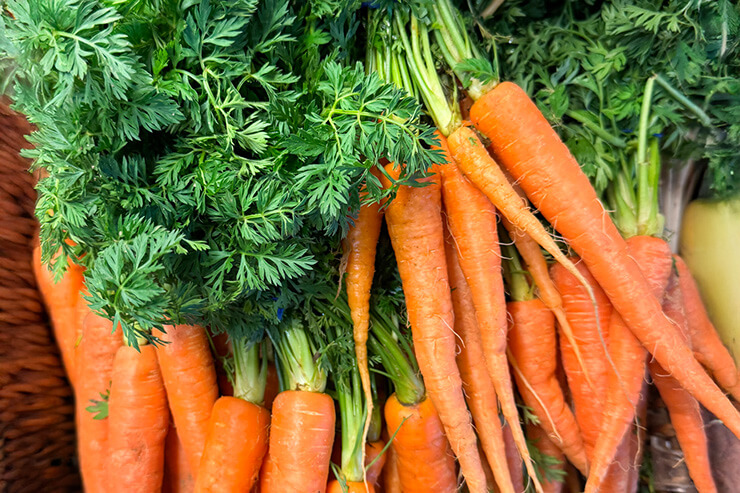
Every time you toss carrot greens into the trash or compost bin without a second thought, you’re discarding what might be the most nutritious part of your harvest. Those feathery, emerald fronds aren’t just pretty garden decoration – they’re a culinary goldmine hiding in plain sight, packed with more nutrients than the orange roots we prize so highly.
As gardeners, we spend months nurturing our carrots from tiny seeds to full-grown beauties, yet most of us treat roughly half the plant as waste. It’s time to change that mindset and embrace the full potential of Daucus carota.
Here’s where things get fascinating from a plant biology perspective. Carrot tops contain significantly higher concentrations of several key nutrients compared to their underground counterparts. While carrot roots are famous for beta-carotene (which converts to vitamin A), the greens actually contain six times more vitamin C, substantial amounts of vitamin K, potassium, and calcium.
The reason for this nutritional concentration lies in the plant’s biology. Carrot greens are the photosynthetic powerhouses, constantly producing and concentrating nutrients through sunlight. The roots, while storing energy as sugars and some nutrients, primarily serve as the plant’s storage organ. Think of it this way: the tops are the factory, while the roots are the warehouse.
One particularly nerdy detail that excites me: carrot greens contain high levels of porphyrins, the same compounds that make chlorophyll so beneficial. These give the greens their distinctive earthy, slightly bitter flavor – which brings us to the culinary possibilities.
Culinary Adventures with Carrots
The key to cooking with carrot tops lies in understanding their flavor profile. Fresh, young greens have a bright, parsley-like taste with hints of celery and a subtle bitterness that adds complexity to dishes. As they mature, they become more assertive, making them perfect for robust preparations.
Carrot Top Pesto is perhaps the most revelation-inducing way to use these greens. Replace half the basil in your traditional pesto recipe with tender carrot fronds. The result is a more complex, earthy pesto that pairs beautifully with root vegetables. Pro tip: blanch older, tougher greens for 30 seconds before using to mellow their intensity.
Chimichurri Verde gets an incredible upgrade with carrot tops. Mix equal parts carrot greens and parsley with garlic, red wine vinegar, and olive oil. The carrot tops add a subtle sweetness that balances the herb’s sharpness perfectly. I’ve served this to skeptical dinner guests who inevitably ask for the recipe.
For soups, carrot tops shine in two ways. First, they make an excellent addition to vegetable broths – those same porphyrins that create the bitter notes also add incredible depth. Second, finely chopped tender tops can be stirred into soups just before serving, much like you’d use fresh herbs.
Here’s a gardener’s secret: harvest carrot tops progressively throughout the growing season. Young thinnings (those baby carrots you pull to give others space) have incredibly tender, mild greens perfect for raw applications like salads or garnishes.
Varieties That Deliver on Flavor
Not all carrot varieties produce equally delicious tops. Through years of growing different cultivars, I’ve discovered some clear winners for green enthusiasts.
‘Purple Haze’ carrots produce some of the most flavorful tops I’ve encountered. The greens have a robust, almost spicy quality that works beautifully in pestos and chimichurri. The anthocyanins that create the purple color seem to extend into more complex flavor compounds in the foliage.
‘Atomic Red’ carrots develop tops with an unusually sweet, almost licorice-like undertone. These are incredible raw in salads or as a garnish for roasted vegetables.
Traditional orange varieties like ‘Nantes’ and ‘Chantenay’ produce reliable, classic-tasting greens with that perfect parsley-celery flavor profile. These are your workhorses for everyday cooking.
For those interested in heirloom varieties, ‘Oxheart’ carrots produce unusually broad, substantial tops that hold up well to cooking methods like sautéing or braising.
The Compost Connection
Even if you’re not ready to embrace carrot tops in your kitchen, they’re composting gold. Their high nitrogen content makes them excellent “greens” for your compost pile, balancing carbon-rich “browns” like dried leaves or paper.
Here’s a composting tip that might surprise you: carrot tops break down relatively quickly due to their tender nature, but they also help create air pockets in compost piles, improving aeration. This is especially valuable if you’re composting a lot of dense kitchen scraps.
Growing for the Greens
If you’re inspired to grow carrots specifically for their tops, consider succession planting every two weeks. This gives you a constant supply of tender young greens throughout the growing season. Plant varieties closer together than you normally would – you’ll harvest many as baby carrots with their prized young tops.
The next time you pull carrots from your garden, pause before you reach for the compost bin. Those feathery tops represent months of photosynthesis, concentrated nutrition, and untapped culinary potential. Whether you’re whipping up a vibrant pesto, adding depth to your next soup, or creating the most flavorful chimichurri your guests have ever tasted, carrot tops deserve a place at your table.
After all, we gardeners understand better than anyone that plants are meant to be appreciated in their entirety. It’s time our kitchens caught up with our gardens.
Learn how to choose the carrots that are right for you, whether you have a sprawling garden, a couple of raised beds, or only room enough for container gardening. We’ll get you on your way to a delicious carrot harvest with our Crunchy Carrots Gardening Guide – Available Now!
What else do you have to add about carrot tops?


 Previous
Previous

